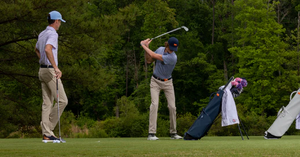How Many Golf Lessons Does a Beginner Need?
Golf is a lifetime sport in multiple ways. Players can often enjoy it their whole lives, even well into their later years, because it's relaxing and less strenuous on the body than many sports. It's also an activity you can constantly improve over a lifetime of practice.
Everybody starts somewhere, but the sooner a beginner starts taking golf lessons, the quicker they'll be equipped with the basic strategies and skills needed to master the craft. Even just a few golf lessons can make a significant impact with the proper instruction.
But how many golf lessons does a beginner need, and what can you expect to learn during your first few lessons? Are there any mistakes or shortcomings that might impact the ideal number of classes you need?
We're covering all that and more below in our in-depth look at beginner golf lessons.
How Many Lessons Should a Beginner Take?
The general recommendation to keep in mind is 3-5 golf lessons to get a beginner started with the correct fundamentals. Many golf clubs or training centers offer beginner lesson packages, so you can buy a set number of classes and save a few dollars in the process.
One lesson is not enough. Even if you scheduled a class that lasted an entire day, it would be too difficult to process the information and retain it to improve your performance.
For best results, aim for at least three. Going for four or five lessons may provide additional time to take the basics you learned in the first three lessons and apply them to your golf game.
What Does a Beginner Learn in the First Few Lessons?
The first few golf lessons cover a ton of information. While you might get overwhelmed at first, taking time to practice in-between classes will help you digest the lessons taught and integrate them into your swing. Topics that you can expect to cover in your first 3-to 5 golf lessons include (but aren't limited to):
Game of Golf and Clubs Used
Each player should get started with a general introduction to the game of golf: how it works, who the players are, what the most important rules are, a bit of history about the game, and perhaps highlighting some of the top players.
Many students already are somewhat familiar with the game of golf, giving them a leg up when they get started with formal training. If you're able to skip over that first part, you can jump into the details about what clubs you have the option of and what each club does.
You'll learn which clubs are best for the long game, short game, chipping, and putting. Most fundamentally, you'll always know which one to grab for the type of shot you need to make.
Grip, Stance, Posture, and Address
The first applicable skill to learn is your grip, which is the only point of contact you'll have with the club.
Knowing how to hold the club properly will give you power, stability, and confidence for your swing and create momentum to send your ball forward. However, the grip isn't as straightforward as you might think. One of the most common mistakes new golfers make is either holding it too loosely, or more prevalent, too tightly.
Next, you'll dive into the basics of grip, stance, posture, and address. These fundamentals will help you get into the correct position before hitting the ball.
The address position is where you will need to stand to hit the ball initially, and the way you stand is known as your stance. The address describes placing the club directly behind the ball once you're in position. Your posture in this position is also essential; you'll need to maintain this position throughout your swing.
Ball Position and Alignment
You'll also go over ball position and alignment. Ball position describes the positioning of the ball within your stance and impacts the outcome of your shot. Alignment ensures you're hitting the ball in the right spot to send it in the direction you wish.
The above makes up the fundamentals before you strike a ball.
Swing Plane, Backswing and Take Away, Downswing and Transition
The swing plane is the arc you swing your club through to generate the velocity you need to hit the ball. The plane may be shallow or steep.
Mechanism for Power and Balance and Rhythm
Your mechanism for power is your takeaway and backswing, downswing and transition, and weight shift and shoulder turn.
Your club's movement away from the ball is your takeaway and the beginnings of your backswing. Your teacher will ensure you drag the club along the grass for the first six inches of your takeaway.
Then, you'll begin your downswing towards the ball to begin to develop your power as you transition. Finally, you'll transfer your weight and turn your shoulder to send the ball flying.
Your teacher will also go over the basics of balance and rhythm, which is key to improving your ability to hit the ball every time.
Long Game
Once you've got these basics of hitting the ball down, you'll move into learning how to hit the ball long, using your driver, hybrids, and long/medium irons.
You'll likely notice that the driver is a hard one to master—that's typical, so don't feel singled out because of it. Most people struggle with this when they're getting started.
After the driver, the 2, 3, and 4 iron are also pretty tricky. Most of the time, the difficulty comes from hitting these too hard. The clubs are designed to shoot long distances, so you don't have to hit them as hard as you might think.
Short Game
It's also important to master the short game, including your sand-wedge and irons from 8 and higher. These are commonly known as your scoring irons because they'll get the ball in the hole for you.
These short game clubs are much easier to hit consistently because of their loft. It's no wonder they are what golfers call the "recovery irons"—they can help even the golfers who struggle the most recover some points on the course.
Accuracy is far more important than distance for these clubs, so swinging the clubs smoothly while maintaining excellent control is paramount.
Chipping
Learning the art of chipping will help you cut down on your handicap because you'll be able to manufacture better short shots.
As you're just getting started, don't put too much pressure on yourself to nail the fancy flop shots. Instead, just aim to get your ball on the green and let it roll into the hole on its own.
Putting
Putting might be the most significant way you can improve your game. It's also the easiest skill to work on yet the least practiced by most amateurs. Honestly, you should practice putting on your carpet if the weather's not good, and outside any time it's sunny.
Putting practice doesn't have to take a lot of time. It can mean a few shots after work here and there, but the consistency is what adds up.
Once you've got the basics down, you can begin developing your style and stance and increasing your comfort level over the ball to improve your performance. Sure, it's not as exciting as bombing a ball on the range, but the repetition of your stroke and committing it to muscle memory will help you immensely.
What Should a Beginner Bring to Their First Golf Lessons?
A beginner should show up ready to go for the first golf lesson. In addition to being prepared with the right mindset, players should also show up with the items they'll need to make the most of their class.
Golf Clubs You Own
If you own golf clubs, bring them! Most beginners don't have their first set of clubs yet, which is fine. If you've signed up for beginner's lessons, they'll have the option of borrowing clubs from your trainer available.
However, if you do own them, and they are yours (and not just borrowed from a friend or family member), you'll want to bring them so you can practice with them as much as possible.
Proper Golf Apparel and Accessories
You will also need to bring the proper golf apparel and accessories. Bring a golf glove to prevent blistering on your hands and give you a better grip.
Also, wear the right shoes. They should be athletic shoes with a good grip without spikes that could damage the course. Don't wear sandals or dress shoes.
Sun Protection and Hydration
A day on the golf course (or a day of training for the golf course) is usually spent out in the sun. You need to stay protected from the sun, so bring a hat and SPF to reapply.
Being outside in the sun can also dehydrate you, so bring a bottle of water that you can sip on as you need it.
Notebook
At a good beginner's lesson, you'll be learning a lot. While some people learn better by just practicing with their bodies, other learners need written reminders to avoid losing important details after the lesson is over.
Bringing a notebook and pen can be helpful, allowing you to jot down pointers and tips as you go that you can reference later on.
A notebook or paper is also a handy item to carry with you on the course to track your golf scores.
Which Factors Affect the Number of Golf Lessons You Need?
Three to five lessons is a good recommendation for a beginner golfer, but it's not a one-size-fits-all approach. To figure out the ideal number of lessons you need to start playing golf more confidently, you should consider three key factors, including how much progress you want to make, how much each lesson costs, and how much work you're putting in between your lessons.
How Much Progress the Golfer Hopes to Make
Golf lessons are available either as construction or correction lessons.
As they're named, construction lessons help construct a golf skill from scratch. They target new and young golfers, covering all the basics in great detail.
On the other hand, correction lessons amend an existing golfer's swing.
Construction lessons are more challenging because there's no foundation for the new golfer. That said, they can be much more efficient, only requiring one or two to make the desired change. It's easier to form a new habit than break a bad one.
If you're a beginner taking construction lessons and you want to make significant progress in your skills, prepare for at least five classes, maybe more. However, if you're only looking to learn the basics, three might suit you. And if you only want to make changes to a pre-existing swing, one or two might do the trick.
Cost Per Lesson
For most people, the cost will also be a factor that impacts how many lessons they'll want to take. Golf lesson prices can vary greatly, depending on where you're taking them and who's teaching them. If classes are relatively expensive, you'll likely opt to take fewer.
However, if you can get them at a better rate as a package deal, you may be able to get more without breaking the bank.
Practice Time Outside of Lessons
Practicing outside of your lessons is the best way to maximize your return. It gives you time to apply the teaching you've learned, get them into your muscle memory, and ingrain new techniques. The more time you can dedicate to honing your craft outside of lessons, the fewer lessons you'll need.
To maximize this, schedule your lessons at least a few days apart, so you have time to practice on your own.
Scheduling five classes in a row over a week is not a good idea, as it won't allow you to let the lessons digest.
Tips to Make Sure Golf Lessons Improve Your Game
Simply attending golf lessons doesn't guarantee any sot of improvement. To make a difference, follow these tips both during and in-between lessons:
Create a Specific Goal for Each Lesson
Break things down into smaller, more attainable goals that you can reach each lesson. Share this goal with your trainer so they can provide feedback on whether that is or isn't achievable to ensure you're setting realistic goals that you can accomplish.
Improve Your Weaknesses
If you're great with your wedges, then don't spend your entire lesson time hitting with wedges. Focus on improving your current weaknesses, whatever they may be. Use your trainer to help identify weak points and focus on making progress there to improve your handicap.
Work on Finding the Right Teacher
Your first teacher might not be the right one. If you don't feel like it's a good fit, try again. Ask friends if they can recommend anyone, or use online reviews to learn more about students' direct experience working with them.
Prepare for Hard Work Between Lessons
The work doesn't end when the lesson does. If you want to see progress made from one lesson to the next, you have to commit to practicing on your own as much as you can.
Interact with Your Teacher
Golf lessons shouldn't be a form of one-way communication. They should be interactive, so don't be scared to ask questions, give feedback on what is and isn't helping, and tell them when something doesn't make sense.
Remember, you're paying for these lessons. Be sure you're getting what you want out of them.
Final Thoughts
There's no singular prescription for beginner golf lessons that will work for everyone. Each player is unique in their skill level, availability, practice consistency, and the level of improvement they hope to achieve during their lessons. As such, every beginner should take an individualized approach to determine how many classes to take to get started.
Consider things like cost, your current level of skill, goals for the lessons, and time to practice, and get together with an experienced trainer to determine the best lesson structure and amount for you.
Ready to hit the course? Trust the experts at Stitch Golf for all your needs, from apparel to golf bags and equipment.


